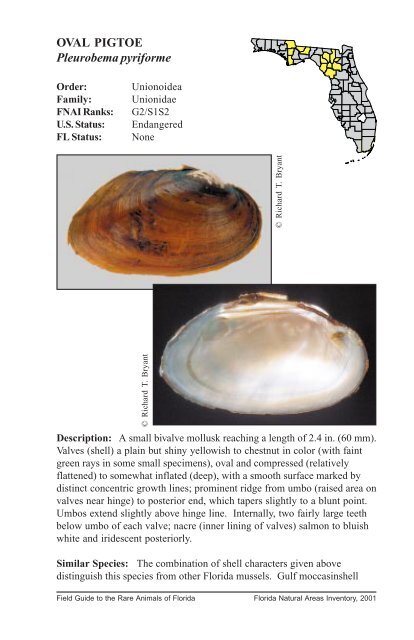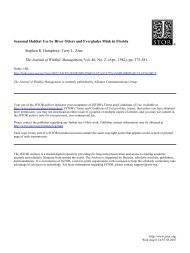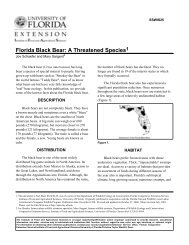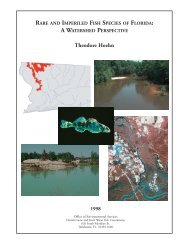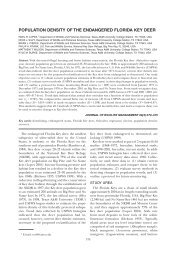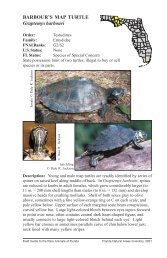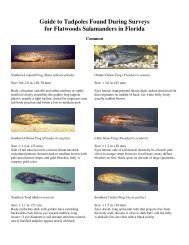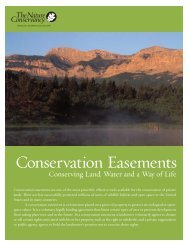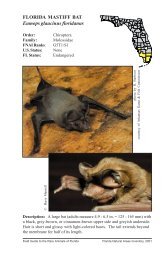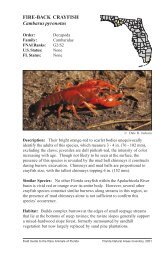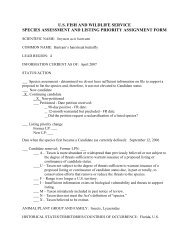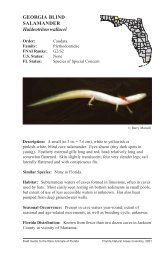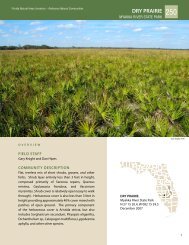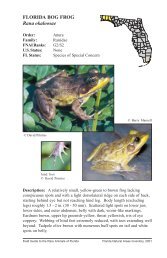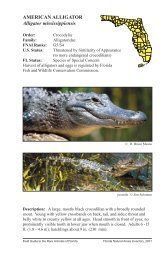Oval pigtoe - Florida Wildlife Conservation Guide
Oval pigtoe - Florida Wildlife Conservation Guide
Oval pigtoe - Florida Wildlife Conservation Guide
You also want an ePaper? Increase the reach of your titles
YUMPU automatically turns print PDFs into web optimized ePapers that Google loves.
OVAL PIGTOE<br />
Pleurobema pyriforme<br />
Order:<br />
Family:<br />
FNAI Ranks:<br />
U.S. Status:<br />
FL Status:<br />
Unionoidea<br />
Unionidae<br />
G2/S1S2<br />
Endangered<br />
None<br />
© Richard T. Bryant<br />
© Richard T. Bryant<br />
Description: A small bivalve mollusk reaching a length of 2.4 in. (60 mm).<br />
Valves (shell) a plain but shiny yellowish to chestnut in color (with faint<br />
green rays in some small specimens), oval and compressed (relatively<br />
flattened) to somewhat inflated (deep), with a smooth surface marked by<br />
distinct concentric growth lines; prominent ridge from umbo (raised area on<br />
valves near hinge) to posterior end, which tapers slightly to a blunt point.<br />
Umbos extend slightly above hinge line. Internally, two fairly large teeth<br />
below umbo of each valve; nacre (inner lining of valves) salmon to bluish<br />
white and iridescent posteriorly.<br />
Similar Species: The combination of shell characters given above<br />
distinguish this species from other <strong>Florida</strong> mussels. Gulf moccasinshell<br />
Field <strong>Guide</strong> to the Rare Animals of <strong>Florida</strong> <strong>Florida</strong> Natural Areas Inventory, 2001
OVAL PIGTOE<br />
Pleurobema pyriforme<br />
(Medionidus penicillatus; see species account) is equally small and can be<br />
brownish but tends to have greenish radiating lines on the valves. Because<br />
many mussels are similar externally, identity should always be confirmed<br />
by an expert.<br />
Habitat: Medium-sized creeks to small rivers, usually with slow to<br />
moderate current and clean substrates of silty sand to sand-gravel mix.<br />
Seasonal Occurrence: Present year-round.<br />
<strong>Florida</strong> Distribution: Chipola, Ochlockonee, and Suwannee (especially<br />
Santa Fe and New rivers) river systems and Econfina Creek (Bay County).<br />
Range-wide Distribution: Beyond <strong>Florida</strong>, extends northward into<br />
Georgia in Ochlockonee, Flint, and Chattahoochee river systems.<br />
<strong>Conservation</strong> Status: In severe decline. Although portions of floodplains<br />
of inhabited river systems are in public ownership, habitats still face<br />
multiple forms of degradation as well as introduced Asian clam (Corbicula<br />
fluminea).<br />
Protection and Management: Protect inhabited streams and rivers from<br />
pollution, siltation, impoundment, and other disturbance. Limit<br />
withdrawal of surface and subterranean waters as necessary to maintain<br />
normal stream flows, especially during drought. Protect forests along<br />
floodplain and at least 150 ft. (ca. 50 m) of adjoining upland from timber<br />
harvest, livestock, and development. Situate roads at least 0.25 mi. (0.4<br />
km) from heads of all tributaries, and even more on steep slopes. Use silt<br />
fencing and vegetation to control runoff and siltation at all stream<br />
crossings, especially during construction and maintenance. Prohibit<br />
dredging and damming of streams and rivers. Avoid introduction of nonnative<br />
invertebrates, especially zebra mussel (Dreissena polymorpha);<br />
monitor and attempt to control Asian clam. Use and maintain sewer<br />
systems rather than septic tanks and stream-dumping for management of<br />
waste water. Ban use of agricultural pesticides on porous soils near streams.<br />
Maintain fish populations (sailfin shiner) that serve as mussel larval hosts.<br />
Selected References: Brim Box and Williams 2000, Deyrup and Franz<br />
(EDS.) 1994, Georgia DNR 1999, U.S. Fish and <strong>Wildlife</strong> Service 1998b.<br />
Field <strong>Guide</strong> to the Rare Animals of <strong>Florida</strong> <strong>Florida</strong> Natural Areas Inventory, 2001


